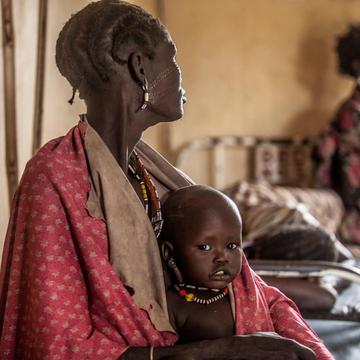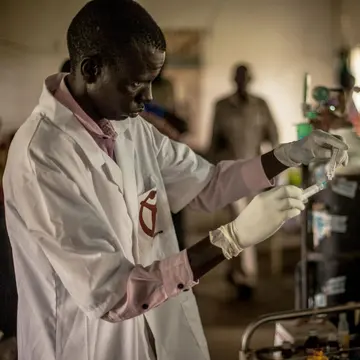
One year-old Hakaroom sits with his mother Lokuru at a Save the Children-supported health center in Kapoeta, South Sudan, after being treated for severe. Photo credit: Martin Kharumwa / Save the Children, October 2017.
The Injustice in Dying from Pneumonia
When Lokuru brought her 1-year-old baby to get food at Save the Children’s stabilization center in northern Kapoeta, South Sudan, she had another concern on her mind. The night before, her daughter Hakaroom’s breathing had become heavy and labored. Her small body was starting to feel hot. A nurse at the center recognized Hakaroom’s symptoms as pneumonia and sent her to the Primary Health Care Center, where the infant was treated for severe pneumonia with antibiotics and fluids. All of Lokuru’s four children have suffered from pneumonia at some point in their lives, but Hakaroom’s case was the worst. According to the Save the Children medic who treated Hakaroom, without immediate medication, she would not have lived through the night.
Why are Children Dying from Pneumonia?
Pneumonia killed 808,694 children under the age of 5 in 2017, accounting for 15% of all deaths of children under five years old.[i] We know how to prevent, diagnose and treat pneumonia, and we have known for a long time. So why do so many children around the world still lose their lives to this disease?
The micro-organisms that cause pneumonia are dangerous for all children. What makes them lethal is a combination of background risk and the failure of health systems to prevent or to detect, diagnose and treat pneumonia cases.
Pneumonia Remains a Disease of Poverty
While you often hear people describe an illness with the cliché, “it doesn’t discriminate,” that couldn’t be further from the truth. Pneumonia discriminates.
Pneumonia is a disease of poverty. 99% of child deaths from pneumonia occur in developing countries. Within these high burden countries, it is the poorest and most marginalized children who are at greatest risk. A child should not die because of where she was born or what resources her family has.
The world’s poorest children are more likely to suffer pneumonia risks such as malnutrition, indoor air pollution and a lack of primary healthcare. If they do get sick with pneumonia, they are the least likely to get medical treatment. Each year, about 40 million cases of pneumonia are left untreated.
A Complex Challenge: Accessible and Affordable for All
Failures of prevention, diagnosis and treatment underscore the critical importance of universal health coverage. Currently, some 400 million people lack access to health care, while 100 million are driven into poverty by unaffordable health costs.
Winning the battle against pneumonia will require wider changes that make healthcare accessible and affordable for all.

A Save the Children nurse at hospital in South Sudan prepares to treat a baby for pneumonia. Photo credit: Martin Kharumwa / Save the Children, October 2017.
Combatting Pneumonia
Save the Children is a leader when it comes to combatting pneumonia. We have been preventing and treating the disease in children for decades. We can prevent pneumonia by increasing immunization, addressing undernutrition, ensuring safe water, sanitation and hygiene, and reducing household air pollution.
Most cases of pneumonia can be treated with antibiotics costing less than $0.40 for a full course. But if a child with pneumonia does not receive care, or their condition is misdiagnosed, their condition can deteriorate very rapidly.
Nearly all childhood deaths from pneumonia are preventable through proper diagnosis and treatment. Simple technologies are available that could, in the hands of properly trained and supported health workers, save lives. Yet these technologies are seldom available in low-resource settings – and there is insufficient investment in the innovations needed to adapt new technologies to real conditions in high-burden pneumonia countries.
There is an urgent need to mobilize the resources, build the partnerships and spur the innovations that could revolutionize the diagnosis and treatment of pneumonia on the frontline.[ii]
Your Donation Can Save Lives
Through the generous support of our donors, Save the Children remains committed to putting the number one child killer on the map. Our pledge to end preventable childhood deaths by 2030 is directly tied to our ability, made possible through the generosity of supporters like you, to do whatever it takes to fight pneumonia.
[i] WHO
[ii] UNICEF
